#ContinuousDelivery
Explore tagged Tumblr posts
Text
youtube
The Best DevOps Development Team in India | Boost Your Business with Connect Infosoft
Please Like, Share, Subscribe, and Comment to us.
Our experts are pros at making DevOps work seamlessly for businesses big and small. From making things run smoother to saving time with automation, we've got the skills you need. Ready to level up your business?
#connectinfosofttechnologies#connectinfosoft#DevOps#DevOpsDevelopment#DevOpsService#DevOpsTeam#DevOpsSolutions#DevOpsCompany#DevOpsDeveloper#CloudComputing#CloudService#AgileDevOps#ContinuousIntegration#ContinuousDelivery#InfrastructureAsCode#Automation#Containerization#Microservices#CICD#DevSecOps#CloudNative#Kubernetes#Docker#AWS#Azure#GoogleCloud#Serverless#ITOps#TechOps#SoftwareDevelopment
2 notes
·
View notes
Text

Increase productivity, reduce errors, and maximize ROI with ITTStar’s DevOps solutions. We help financial firms streamline workflows, minimize downtime, and accelerate software delivery—all while maintaining the highest quality standards. Let us help you achieve operational excellence and stay ahead of the competition. Get in touch today to see how we can drive efficiency in your organization.
#devops#devsecops#cloud services#cloud migration#genai#aws services#automationsolutions#businessgrowth#continuousdelivery#maximizeroi#cloudsolutions
0 notes
Text
Thinking About Implementing DevOps in Your Enterprise? Here's Your Strategy Roadmap!
In today’s fast-paced digital world, enterprises can't afford delays, miscommunication, or inefficiencies in software delivery. That's where DevOps comes in—bridging the gap between development and operations to deliver faster, more reliable solutions.
But DevOps isn’t a one-size-fits-all plug-and-play model. To truly benefit, enterprises need a well-thought-out strategy that aligns with their business goals, culture, and existing infrastructure.
In our latest blog at Rlogical, we break down a clear and actionable DevOps implementation roadmap to help enterprises transform their IT delivery:
🔹 Define Clear Objectives – Start with a business-aligned vision for DevOps success 🔹 Assess Readiness & Gaps – Evaluate your current workflows, tools, and team capabilities 🔹 Build a Collaborative Culture – Tear down silos and encourage cross-functional teamwork 🔹 Implement Automation – Streamline CI/CD, testing, monitoring, and deployment 🔹 Start Small, Scale Smart – Begin with pilot projects, then expand organization-wide 🔹 Measure, Optimize, Repeat – Use metrics and feedback loops to drive continuous improvement
Whether you're just starting or refining your DevOps practices, this guide provides insights that can save time, reduce friction, and increase innovation.
🔗 Read the full article here: 👉 https://www.rlogical.com/blog/strategies-for-implementing-devops-enterprise/
Let us know in the comments: Where are you on your DevOps journey?
#DevOps#DevOpsTransformation#EnterpriseDevOps#DevOpsStrategy#SoftwareDevelopment#usa#uk#canada#france#australia#Agile#CI_CD#Automation#DigitalTransformation#CloudComputing#ITStrategy#TechLeadership#Innovation#ContinuousDelivery#Rlogical#DevOpsCulture#ScalableSolutions#BusinessAgility
0 notes
Text
"Continuous Delivery" by Jez Humble and David Farley is a seminal book that provides a comprehensive guide to achieving reliable, rapid, and repeatable software delivery. The book outlines principles, practices, and techniques that enable teams to deliver high-quality software efficiently. Below is a user-friendly, step-by-step breakdown of the key outcomes and takeaways from the book, designed to help readers understand and implement continuous delivery effectively.
#ContinuousDelivery#DevOps#SoftwareDevelopment#Automation#CI/CD#Deployment#ContinuousIntegration#Agile#SoftwareEngineering#AutomationTesting#DevOpsCulture#ReleaseManagement#DevOpsPractices#DeploymentPipeline#SoftwareRelease#AutomationTools#AgileDevelopment#TechTrends#DevOpsTools#ContinuousDeployment#InfrastructureAsCode#BuildAutomation#SoftwareTesting#TechTutorial#CloudComputing#ITOperations
0 notes
Text
The history of Agile is a testament to the power of collaboration, flexibility, and continuous improvement. From its early roots in iterative development to its widespread adoption across industries, Agile has transformed the way organizations operate. As Agile continues to evolve, embracing new technologies and methodologies, it will undoubtedly remain a cornerstone of modern project management and software development.
#Hashtags#Agile#Scrum#Kanban#XP#SAFe#AgileManifesto#DevOps#Lean#BusinessAgility#Sprint#ContinuousDelivery#TDD#SoftwareDevelopment#ProjectManagement#AgileTransformation
0 notes
Text
What is the Continuous Process of DevOps?
The continuous process of DevOps involves seamless collaboration between development and operations teams to deliver high-quality software faster. By integrating continuous integration, continuous delivery, and continuous monitoring, DevOps optimizes the software development lifecycle. This process ensures quicker releases, enhanced quality, and improved system reliability, enabling businesses to adapt and innovate rapidly in today's competitive market.
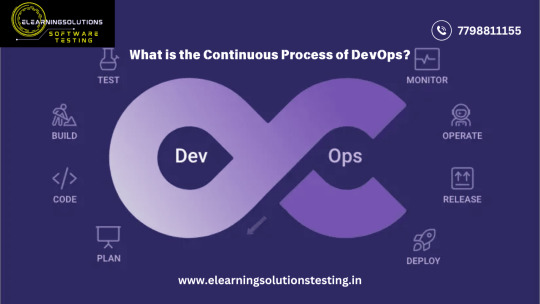
#DevOps#ContinuousIntegration#ContinuousDelivery#SoftwareDevelopment#Agile#TechInnovation#CI_CD#DevOpsCulture#Automation#ITOperations
0 notes
Text
Say Goodbye to Deployment Nightmares!
🚀 Automate. Monitor. Improve. SDH ensures zero-downtime deployments with top-tier DevOps tools. No more failed releases!
0 notes
Text
Best Practices for Automating CI/CD with AWS CodePipeline
In this blog post, we explore the best practices for automating Continuous Integration (CI) and Continuous Delivery (CD) using AWS CodePipeline. Learn how to streamline your software development lifecycle, improve collaboration, and enhance productivity with a seamless CI/CD pipeline on AWS. Whether you're a beginner or an experienced developer, these practical tips will help you achieve faster, more reliable deployments.
Visit the full blog for more insights and resources on AWS and DevOps automation: Best Practices for Automating CI/CD with AWS CodePipeline

#AWS#CICD#CodePipeline#DevOps#Automation#SoftwareDevelopment#CloudComputing#ContinuousIntegration#ContinuousDelivery#CloudDevOps#AWSDevOps#AWSCodePipeline#AutomationBestPractices#TechTips
1 note
·
View note
Text
Enterprise Cloud Adoption and Management: Key Factors
Gartner reported that the public cloud infrastructure as a service (IaaS) market grew 31.4% in 2016 (see “Market Share: Public Cloud Services, Worldwide, 2016”), resulting in a $22.6 billion market in 2016. While Amazon Web Services (AWS), Microsoft Azure and Alibaba are the leading cloud IaaS providers, the rest account for 46% of revenue share in 2016. An increased number of Centizen’s customers are leveraging the advantages of cloud infrastructure at their organization’s core. There are several key factors of enterprise cloud adoption and management to consider when investing in any cloud platform: Many IaaS providers offer easy ways to create, modify and remove core infrastructure components. Infrastructure provisioning processes should be comprised of independent and valuable tasks which offer a high degree of reuse across operations. The task of provisioning and configuring infrastructure with the appropriate base software means consistency and standardization across all enterprise applications. Processes that take advantage of standardization, result in greater infrastructure stability.

Governance and policy
This is one of the key capabilities which most organizations catch up on at a later stage in their cloud adoption. At the core, this demands clearly defining what users can do and establishing limits. A lack of cloud governance can lead to security holes, cloud sprawl, integration problems or shadow IT.
Monitoring and metering
Monitoring consumption of the cloud resources is an important lens to view cloud expenditure.
Cost transparency and optimization
This involves enabling tracking, budgeting and optimization of the cloud expenses. This is closely tied to orchestration and automation. Ensure all cloud resources are accounted for, all stakeholders and departments have visibility, cost is fully allocated and cloud governance is in place.
Capacity and resource optimization
The efficient operational use of the infrastructure footprint is an important factor. Capacity management is the practice of planning, managing, and optimizing IT infrastructure resource utilization so performance is high and infrastructure cost is low. It’s a balancing act of cost vs. performance that requires insight into the current and future usage.
Cloud migration and disaster recovery
Disaster doesn’t come with an appointment. Cloud readiness determination, discovery, lifting and shifting of workloads between and/or among on-premises and off-premises environments. It also requires workloads to be permanently migrated from one environment to another, and workloads re-positioned.
Security and identity management
There are various security-related functionalities needed in a cloud computing environment (for example, risk management, segregation of duties, single sign-on and key management), particularly those involving public cloud services. Restrict access with Active Directory, Security Assertion Markup Language or Lightweight Directory Access Protocol systems. Additionally, scanning and re-mediating deployed infrastructure for security vulnerabilities is needed where the remediation is performed by Provisioning, Orchestration and Automation.
Continuous delivery
It focuses on automating the software delivery process so that teams can easily and confidently deploy their code to production at any time. By ensuring that the code base is always in a deployable state, releasing software becomes an unremarkable event without a complicated ritual. Teams can be confident that they can release whenever they need to without complex coordination or late-stage testing. As with continuous integration, continuous delivery is a practice that requires a mixture of technical and organizational improvements to be effective.
Summary
Centizen’s cloud consulting and contract staffing services help our clients accelerate their journey to the cloud. For those already there, we can help you transform your enterprise cloud adoption with cloud infrastructure and reduce operational costs. We also help our customers with the selection and implementation of open-source applications to run in your cloud. Centizen’s cloud services put enterprises on the right track to fast and successful cloud optimization.
#CloudAdoption#EnterpriseCloud#CloudManagement#IaaS#AWS#Azure#CloudInfrastructure#CloudGovernance#CloudOptimization#CostTransparency#ResourceManagement#CloudMigration#DisasterRecovery#CloudSecurity#IdentityManagement#ContinuousDelivery
0 notes
Text
Cypress with Jenkins CI/CD: A Robust Automation Framework
#Cypress#Jenkins#CICD#AutomationFramework#TestingTools#DevOps#SoftwareTesting#ContinuousIntegration#ContinuousDelivery#AutomationTesting#TestAutomation#CypressTesting
0 notes
Text
0 notes
Text
What are the questions asked in DevOps interview for bigginers?
In the competitive IT industry, DevOps is becoming increasingly popular, and aspiring professionals are often asked a variety of questions in interviews. This guide provides you with the top 20 beginner DevOps interview questions, along with detailed explanations to help you prepare confidently.
1. What is DevOps?
Explanation: DevOps is a set of practices that combines software development (Dev) and IT operations (Ops). It aims to shorten the development lifecycle while delivering features, fixes, and updates frequently in alignment with business objectives.
2. What are the key components of DevOps?
Explanation: The key components of DevOps include continuous integration, continuous delivery (CI/CD), automation, infrastructure as code (IaC), monitoring, and collaboration between teams.
3. Explain Continuous Integration (CI).
Explanation: CI is a DevOps practice where developers frequently merge their code changes into a central repository, followed by automated builds and tests. This helps catch bugs early and speeds up the development process.
4. What is Continuous Delivery (CD)?
Explanation: CD ensures that code changes are automatically prepared for a release to production. It builds upon CI and automates the delivery of new updates, ensuring they are ready for production after passing through various test stages.
5. What are some common DevOps tools?
Explanation: Some popular DevOps tools include:
Jenkins for CI/CD automation
Docker for containerization
Kubernetes for container orchestration
Ansible for automation and configuration management
Git for version control
6. What is Infrastructure as Code (IaC)?
Explanation: IaC is a key DevOps practice where infrastructure is defined and managed using code, rather than through manual processes. Tools like Terraform and AWS CloudFormation are often used to automate infrastructure provisioning and management.
7. What is the role of version control in DevOps?
Explanation: Version control, using tools like Git, enables multiple developers to work on a project simultaneously. It keeps track of changes and maintains a history of revisions, ensuring that changes are coordinated and easily reversible.
8. What is Docker, and how does it fit into DevOps?
Explanation: Docker is a containerization tool that allows developers to package applications and their dependencies into a container, ensuring they run consistently across different environments. Docker simplifies deployment and scalability in DevOps workflows.
9. Explain the concept of container orchestration with Kubernetes.
Explanation: Kubernetes is an orchestration platform for managing, scaling, and deploying containerized applications. It automates the distribution of containers across a cluster of machines and handles load balancing, service discovery, and more.
10. What is a microservices architecture?
Explanation: Microservices architecture is an approach where applications are built as a collection of small, independent services. Each service can be developed, deployed, and scaled individually, making the system more resilient and flexible.
11. How do monitoring and logging fit into a DevOps pipeline?
Explanation: Monitoring and logging are crucial for identifying issues in production. Tools like Prometheus, Grafana, and ELK (Elasticsearch, Logstash, and Kibana) are often used to ensure system health, track performance, and troubleshoot problems.
12. What is the difference between Agile and DevOps?
Explanation: Agile is a software development methodology focused on iterative development and collaboration between teams. DevOps extends Agile principles by integrating development and operations, emphasizing automation, continuous feedback, and faster delivery.
13. What is a build pipeline?
Explanation: A build pipeline is a series of steps performed in sequence to automate the creation, testing, and deployment of code. It includes stages like source control, build, test, and deployment, ensuring that every change is properly validated before reaching production.
14. How do you manage configuration in DevOps?
Explanation: Configuration management involves maintaining consistency of systems and software over time. Tools like Ansible, Puppet, and Chef automate the process of configuring servers, ensuring that environments remain consistent across the development lifecycle.
15. What are the benefits of using Jenkins in DevOps?
Explanation: Jenkins is an open-source automation server that facilitates CI/CD processes. Its benefits include:
Easy integration with various DevOps tools
A large library of plugins
Flexibility to automate different tasks
A robust community for support
16. What is GitOps?
Explanation: GitOps is a DevOps practice where Git is the single source of truth for the system’s desired state. It uses Git pull requests to manage and deploy changes to applications and infrastructure, ensuring that changes are trackable and auditable.
17. What is the importance of automation in DevOps?
Explanation: Automation is crucial in DevOps because it reduces human intervention, minimizes errors, speeds up processes, and ensures consistency across deployments. This includes automating CI/CD, testing, infrastructure provisioning, and monitoring.
18. What is a rolling deployment?
Explanation: Rolling deployment is a technique where new versions of an application are gradually deployed to instances, replacing old ones. This ensures zero downtime by keeping part of the application available while the update is being deployed.
19. Explain the role of cloud platforms in DevOps.
Explanation: Cloud platforms, such as AWS, Azure, and Google Cloud, provide scalable and flexible infrastructure that aligns well with DevOps practices. They enable teams to provision resources on demand and integrate with automation tools to streamline deployments.
20. What is the significance of feedback loops in DevOps?
Explanation: Feedback loops ensure that teams get timely information about the performance and issues of their systems. Continuous feedback from users, automated monitoring, and testing tools help to detect problems early and ensure quick iterations.
Accelerate Your DevOps Career with Naresh IT’s DevOps Online Training
DevOps is essential for modern software development, and learning the skills needed to excel in DevOps is critical for your career. At Naresh IT, we offer comprehensive DevOps Online Training to equip you with in-demand skills like CI/CD, Docker, Kubernetes, cloud platforms, and more.
Whether you’re a beginner or looking to upskill, Naresh IT provides tailored content, hands-on labs, and real-world project experience to make you industry-ready.
Join Naresh IT’s DevOps Online Training today and kickstart your DevOps journey!
0 notes
Text
Supercharge Your Cloud Operations with AWS DevOps Consulting Services

In today’s digital landscape, the demand for faster, more reliable software delivery has never been greater. DevOps—a combination of development and operations—has emerged as a critical methodology for organizations striving to achieve seamless integration and continuous delivery. AWS DevOps, powered by Amazon Web Services, offers a robust set of tools and practices that streamline the software development lifecycle. However, implementing these solutions effectively can be challenging without expert guidance, making AWS DevOps consulting services essential for businesses aiming to optimize their cloud operations.
Why AWS DevOps?
AWS DevOps provides a comprehensive suite of tools designed to help companies automate and streamline their software development and IT operations. From continuous integration and delivery to infrastructure as code and monitoring, AWS DevOps offers everything needed to enhance productivity, reduce time to market, and ensure high-quality software delivery. However, setting up and managing these tools requires a strategic approach, and that’s where AWS DevOps consulting services come into play.
Key Benefits of AWS DevOps Consulting Services
Customized DevOps Strategy Every business has unique needs and challenges, which means a one-size-fits-all approach to DevOps won’t work. AWS DevOps consulting services provide a tailored strategy that aligns with your specific business goals, technology stack, and operational requirements, ensuring that your DevOps implementation is efficient and scalable.
Seamless Cloud Integration Integrating AWS DevOps tools into your existing workflows can be complex. Expert consultants ensure smooth integration, allowing your teams to leverage AWS services like CodePipeline, CodeBuild, and CloudFormation to automate and manage deployments, monitor performance, and scale operations seamlessly.
Enhanced Security and Compliance Security is a top priority for any cloud-based operation. AWS DevOps consulting services help you implement best practices in security and compliance, ensuring that your applications and data are protected. This includes setting up secure CI/CD pipelines, managing access controls, and adhering to industry-specific compliance standards.
Cost Optimization AWS offers powerful tools, but without proper management, costs can quickly spiral out of control. Consulting services provide insights into cost optimization strategies, such as right-sizing resources, automating workflows to reduce manual errors, and utilizing AWS cost management tools effectively.
Continuous Improvement and Support The DevOps journey doesn’t end with implementation. Continuous improvement is vital to keeping your operations optimized. AWS DevOps consultants offer ongoing support to refine processes, implement new features, and address any challenges that arise, ensuring your DevOps environment remains agile and efficient.
Choosing the Right AWS DevOps Consulting Partner
Selecting the right partner for your AWS DevOps journey is crucial. You need a partner who not only understands AWS services but also possesses a deep understanding of DevOps best practices and industry-specific challenges. At Feathersoft Info Solutions, we specialize in providing AWS DevOps consulting services tailored to your business needs. Our team of experienced consultants works closely with your organization to design, implement, and optimize your DevOps processes, helping you achieve faster, more reliable software delivery.
Conclusion
AWS DevOps consulting services can transform the way your business operates in the cloud, providing the expertise needed to implement best practices, automate processes, and enhance the overall efficiency of your development lifecycle. Whether you're just starting your DevOps journey or looking to optimize an existing setup, expert guidance can make a significant difference.
#AWSDevOps#DevOps#CloudComputing#AWS#DevOpsConsulting#CloudServices#Automation#ContinuousIntegration#ContinuousDelivery#CloudSecurity#TechConsulting#SoftwareDevelopment#InfrastructureAsCode
0 notes
Text
Agile Insights from Vabro
As we continue to navigate the ever-changing landscape of project management, it's essential to understand the nuances of Agile frameworks. At Vabro, we're committed to helping teams unlock their full potential. Our latest research reveals key trends and insights into the adoption and growth of Scrum and Kanban frameworks. Stay ahead of the curve and learn how these methodologies can transform your workflow!
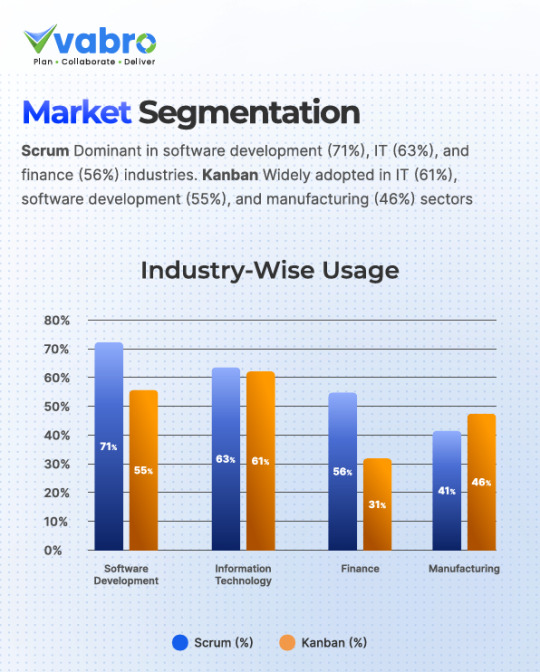
(Source: Grand View Research & Grand View Research)
Market Segmentation:
Scrum: Dominant in software development (71%), IT (63%), and finance (56%) industries
Kanban: Widely adopted in IT (61%), software development (55%), and manufacturing (46%) sectors
Industry-Wide Usage:
Scrum: Preferred by 75% of Fortune 500 companies
Kanban: Adopted by 40% of Fortune 500 companies
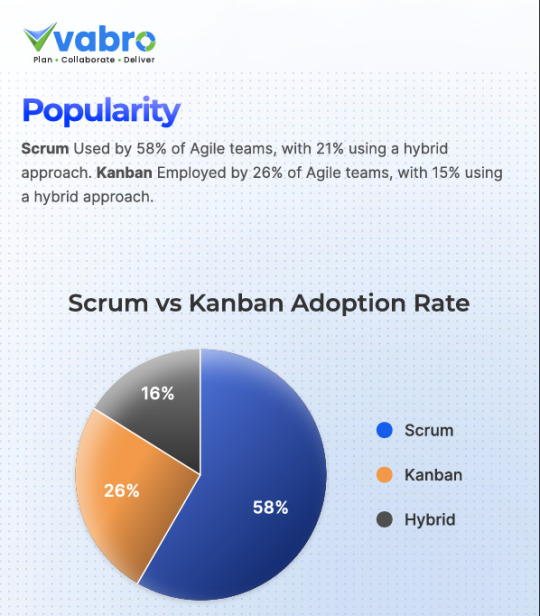
(Source: Grand View Research & Grand View Research)
Popularity:
Scrum: Used by 58% of Agile teams, with 21% using a hybrid approach (Source: VersionOne)
Kanban: Employed by 26% of Agile teams, with 15% using a hybrid approach (Source: VersionOne)

(Source: Grand View Research & Grand View Research)
Growth Prospects:
Scrum: Expected to grow at a CAGR of 12.5% from 2023 to 2030 (Source: MarketsandMarkets)
Kanban: Projected to grow at a CAGR of 10.3% from 2023 to 2030 (Source: Grand View Research)
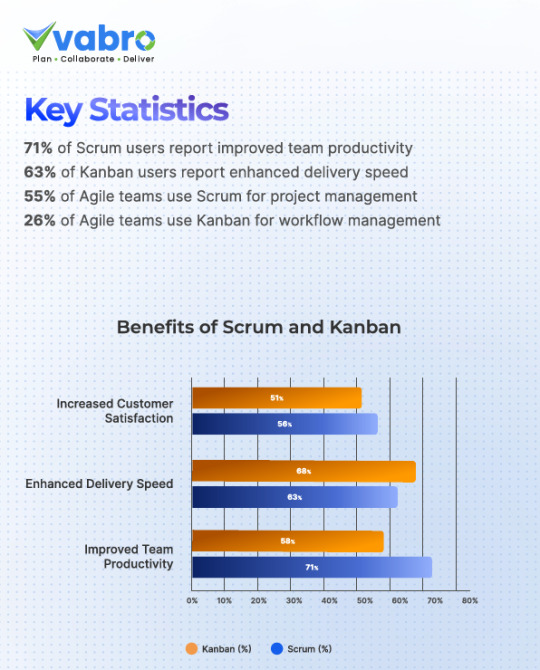
(Source: Grand View Research & Grand View Research)
Key Statistics:
71% of Scrum users report improved team productivity
63% of Kanban users report enhanced delivery speed
55% of Agile teams use Scrum for project management
26% of Agile teams use Kanban for workflow management
Comparison: Scrum and Kanban share similar goals but differ in approach. Scrum excels in:
Prescriptive framework
Iterative development
Role-based responsibilities
Kanban shines in:
Visual workflow management
Continuous delivery
Flexibility and adaptability
Conclusion: Scrum remains the leading Agile framework, dominating the software development and IT industries. Kanban, while less popular, has a strong presence in IT and manufacturing sectors. Both frameworks are expected to grow, with Scrum leading the charge. As the Agile market evolves, understanding the strengths and weaknesses of each framework will be crucial for organizations to make informed decisions and maximize their productivity and efficiency.
Visit www.vabro.com and get started today!
#Vabro#Agile#Scrum#Kanban#ProjectManagement#AgileFrameworks#TeamProductivity#WorkflowManagement#IT#SoftwareDevelopment#Finance#Manufacturing#HybridApproach#MarketTrends#BusinessGrowth#Efficiency#ContinuousDelivery#VisualManagement#AgileInsights
0 notes
Text
Introduction to DevOps Engineer

Embark on a transformative journey into the heart of software development with 'Introduction to DevOps Engineer.' Explore the symbiotic relationship between development and operations, mastering automation, infrastructure as code, and continuous delivery practices. This course equips you with the skills to streamline workflows, enhance collaboration, and drive innovation in today's fast-paced tech landscape. Join London School of Emerging Technology (LSET).DevOps Engineer Course for comprehensive training, industry insights, and hands-on experience, preparing you for a successful career at the forefront of DevOps excellence."
Enrol @ https://lset.uk/ for admission.
0 notes
Text
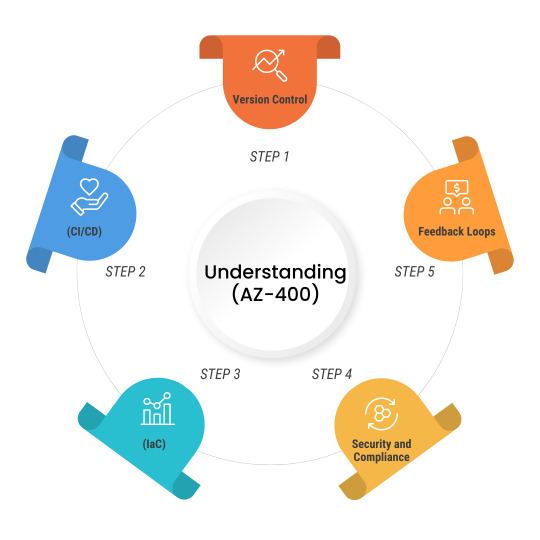
Discover the potential of the AZ-400 Microsoft Azure DevOps Certification! Explore IaC, version control, CI/CD, and other topics. With the help of our in-depth guide, you can advance your career in software development and cloud computing.
#AzureDevOps#DevOpsCertification#MicrosoftAzure#AZ400#CloudComputing#SoftwareDevelopment#ContinuousIntegration#ContinuousDelivery#InfrastructureAsCode
0 notes